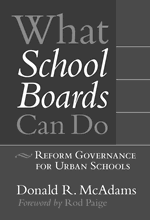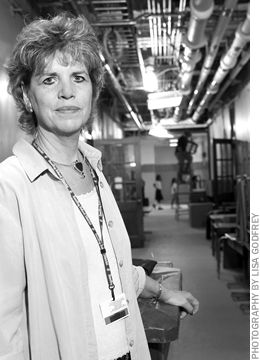Checked:
Michael Winerip, “On Education”
columns for the New York Times,
September and October, 2003
When public schools opened in New York City in September 2003 amid reports of widespread classroom overcrowding, parents, educators, and policymakers demanded an explanation. And there, at the ready, was Michael Winerip, the education columnist for the New York Times.
The crowding, wrote Winerip in the first of a series of hard-hitting columns in September and October of that year, was caused by the “new students with challenging problems” whose parents took advantage of the No Child Left Behind law allowing them to transfer from a persistently failing school to one that was better. The 1,000-word reports were so convincing that even Mayor Michael Bloomberg began blaming NCLB for what Winerip called the “overloading” of Gotham’s middle and high schools. “What the federal law says is that if you are in a failing school, you have a right to demand that your child go to a good school,” the mayor said. “There aren’t any seats in the good schools. Those are full already anyway.”
Unfortunately, it wasn’t true. Months after the Winerip columns appeared, after the federal law had been trashed by editorial writers, teachers, and parents, city education officials released transfer tallies showing that kids looking for better schools under NCLB had gotten a bad rap. If there was new overcrowding-and even that was doubtful in many cases-the federal law had not caused it. (In many cases, in fact, overcrowded classrooms turned out to be in school buildings that had additional space, suggesting that the problem was one of local management.)
Of course, the Times columnist wasn’t alone in fanning the flames of the anti-NCLB hysteria, but his influential columns made it easier for city officials to avoid talking about the real reasons for the problems, namely, a demographic bubble that was moving its way through the city’s middle and high schools, combined with the city’s new initiative to create experimental “schools within schools” in certain buildings, a policy that required a cap on enrollment in some schools at the cost of crowding elsewhere.
For some reason Winerip was intent on finding fault with NCLB. Take Intermediate School 89, in Lower Manhattan, which he profiled in his September 10, 2003, column. He illustrated the problem of the 300-student school’s “newly overcrowded classes” by describing a classroom of 37 students where some children were sitting on benches and on the floor. Winerip quoted a teacher who worried that class size could swell to 40 before all was said and done. The principal, Winerip wrote, had been “informed by city officials that she would be receiving many additional student transfers under the federal No Child Left Behind law.”
Two weeks later, Winerip’s column focused on crowding caused by NCLB at Booker T. Washington Middle School on West 107th Street in Manhattan. “The two 6th-grade classes, taught by Erica Williams and Robyn Block, started with 32 each,” he wrote, “and thanks to federal transfers, ballooned to 43 and 41.” Concluded Winerip, “Like many other middle schools in New York City, this one is overloaded with children who have transferred in under the federal No Child Left Behind law.”
A week later, Winerip crusaded against NCLB overcrowding yet again, announcing in his first paragraph that NCLB “may go down in history as the most unpopular piece of education legislation ever created.” Describing crowded conditions at Public School 19 in the Bronx, the column noted that “Ms. O’Boyle’s 8th grade class had 40 students”-again suggesting that NCLB kids were to blame.
The same column lamented the crowding at Middle School 141 in the Bronx, which grew by 73 students that year. It also noted that enrollment at Intermediate School 192 in the Bronx grew to 1,370, an increase of more than 13 percent from the 1,211 the previous year. All caused by NCLB, Winerip suggested.
What the records show is that most of the worst increases had nothing to do with NCLB.
At P.S. 19, for example, where Ms. O’Boyle had 40 8th graders in her room, records showed that none of those students were there because of the federal law. At Intermediate School 89, where Winerip had described children sitting on the floor, the official data showed that while enrollment grew by 18 students, only 12 were NCLB transfers, and even those were spread out over three grades-seven in 6th grade, four in 7th grade, and one in 8th grade. At Middle School 141, which Winerip complained was overcrowded with 73 new students, it turned out that only 29 of them had transferred to the school under NCLB. At I.S. 192, only 51 students, not 159, as Winerip suggested, had transferred in under NCLB. And at Booker T., the records showed that only nine NCLB transfers ended up in the 6th-grade, even though Winerip had suggested that the 6th-grade classrooms of teachers Williams and Block increased by 20 new students because of the federal law.
The other interesting thing to note about Booker T. was that, NCLB aside, there wasn’t any overcrowding in the school: According to the New York City School Construction Authority, the school was built to hold 1,104 students and was still, officially, 13 children under capacity.
The I.S. 192 building, which Winerip complained had a double-digit increase in its student body, was built for 1,527 students, meaning it still had room to spare after welcoming all the new students in 2003 (only a third of whom, as we saw, actually arrived because of NCLB). And while it isn’t clear why Winerip chose I.S. 89 to profile for his first anti-NCLB installment, it is clear why the city’s education department was steering children in that direction: there was room for an additional 159 students. (After several weeks of school, another 6th-grade teacher was added, further minimizing the impact caused by the seven children who transferred to that grade under NCLB.)
In Winerip’s rush to judgment, he confirmed the fears of many who opposed the transfer provisions of NCLB, including some parents, teachers, and administrators who were eager to blame crowded classrooms on the outsiders who entered under the law.
No doubt there were numerous problems with the way New York City school officials implemented NCLB in the law’s first two school years, as indicated by the city’s recent decision to limit NCLB transfers in the 2004-05 school year. And, undoubtedly, local school administrators in New York City, as most anywhere, can be expected to say their school is overcrowded.
The facts in this case, however, make it difficult to show that transfers under the law caused overcrowding in 2003, when Winerip was complaining; they even suggest that school officials did an uncharacteristically competent job of linking transferring students with schools that were in the best position to accommodate them. An analysis I did for my newspaper, the New York Daily News, compared all 6,979 transfers in the city for 2003-04 with the official building capacity of the receiving schools the previous school year and found that nearly 60 percent of those transfers went to schools with more than enough room to spare.
“We did our best not to overcrowd schools,” said Jeremy Lack, of the city’s No Child Left Behind office. “And at the end of the day, no student who followed through the process was denied a transfer.”
Chancellor Joel Klein even addressed the bad rap that NCLB transfer students were getting in an e-mail to the city’s 1,200 principals that fall (2003). In the e-mail, Klein scolded some principals-though taking care not to name those who complained to Winerip-for trying to “protect their own school regardless of what it means for everyone else.”
Wrote Klein: “Whatever else you may say about No Child Left Behind, it is forcing us to come to grips with a moral imperative that many of us might prefer to ignore: that we have a collective responsibility for the education of over 1 million children.” Needless to say, the New York Times education columnist did not mention Klein’s memo.
But Winerip, by playing fast and loose with the facts, may have succeeded in killing school choice in New York City after all. In the summer of 2004, school officials announced that they were cutting the transfer rate from 7,000 to 1,000. In the midst of a political campaign, federal officials seemed ready to acquiesce in this gutting of one of NCLB’s most important provisions.
Joe Williams is a staff writer on education for the New York Daily News.





